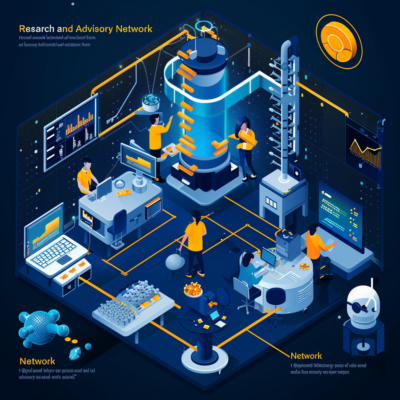
As enterprises recognize the evolving role of data science and analytics within their structures, it becomes crucial to understand how these disciplines have transitioned from isolated tasks within IT and marketing to become central pillars of corporate strategy, shaping the development of dedicated analytics organizations. Initially, analytics was siloed, with disparate teams across departments like accounting and marketing handling data-related tasks without a cohesive strategy or centralized leadership. This fragmentation often led to underutilized data resources and missed opportunities for deeper insights. However, as companies began to realize the strategic advantage offered by robust data analysis, the concept of a unified analytics organization emerged. This shift not only facilitated a more integrated approach to data handling and analysis but also set the stage for analytics to influence major business decisions, integrating data insights directly into the strategic planning process. The establishment of these dedicated analytics organizations marks a significant evolution in corporate structure, reflecting a broader acknowledgment of the value of data-driven decision-making in achieving business objectives.
Building a mature analytics organization requires not only identifying the optimal mix of talent but also continuously evolving these roles to meet the changing demands of the business landscape. As an organization's analytical capabilities grow, so too does the need for a diverse range of skills among its data science and analytics teams. Initially, this might involve assembling a core team of data specialists capable of establishing basic analytics functions and data management practices. Over time, as the organization's data sophistication increases, the scope of required expertise broadens to include advanced predictive analytics, machine learning, and ultimately, artificial intelligence. This progression necessitates ongoing training and development programs to ensure that the workforce remains at the cutting edge of technological and methodological advancements. Moreover, regular reassessment of role requirements and career progression paths for analysts is crucial. It ensures that the organization not only retains its top talent by aligning with their career aspirations but also adapts to emerging trends and technologies that influence the analytics field.
The stages of growth within an analytics organization reflect the broader maturity of the company's analytics capabilities, guided by frameworks such as IIA's Analytics Maturity Assessment (AMA). The AMA tool evaluates an organization’s progress across five stages of analytics maturity, providing actionable insights that drive strategic development. Initially, an organization may only manage foundational data management with limited analytics applications. As the organization progresses, it enhances its data infrastructure and analytics practices to support more complex decision-making processes. This evolution requires not only sophisticated tools and technologies but also a deep understanding of the business context in which these tools are deployed. By the third stage, the organization emphasizes enterprise-wide collaboration, breaking down silos and integrating analytics and AI deeply into strategic functions. This integration fosters a data-driven culture that leverages insights across various business units, enhancing overall corporate performance. Ultimately, the goal is to establish a robust community of practice that not only supports current analytical needs but also anticipates future trends and prepares the organization to respond dynamically.

Analytics Maturity Assessment Brochure
You’ve spent enough time courting technology. To cultivate data-informed decision-making, you must intimately understand and collaborate with your data consumers. We know this is the hardest part of your job and we can make it easier.
Stage 1: Build the Analytics Team
Attracting AI-Driven Talent:
In the initial stage of forming an analytics team, organizations must focus on attracting talent that not only has a strong foundation in traditional analytics skills but also possesses a keen interest and foundational knowledge in AI and machine learning. It's crucial to select individuals who can bridge the gap between business acumen and advanced analytics techniques. Essential skills include basic visualization and coding, but also an understanding of AI applications and machine learning models. The goal is to form a team that is agile and eager to learn, capable of adapting to the evolving landscape of data science.
Talent Retention through Strategic Fit:
Retention strategies should focus on learning from turnover and understanding the needs of AI talents, such as engaging work and growth opportunities. It’s important to assess cultural fit, particularly how well individuals adapt to the dynamic field of AI. Additionally, organizations should be wary of over-qualifying positions, which can lead to dissatisfaction and turnover. Instead, prioritize hiring for potential and flexibility, allowing for career growth as the organization's AI capabilities mature.
Skill Development for AI Integration:
Developing skills that cater to successful AI pilot projects is critical. This involves enhancing data visualization capabilities and fostering a deep understanding of data analysis techniques. However, extending beyond traditional roles, there's a need to incorporate AI-specific training—covering aspects from machine learning algorithms to ethical AI use. This training should aim to expand the team’s ability to handle complex AI-driven projects and innovate beyond conventional data analysis frameworks.
Leadership Focus on AI Value Demonstration:
Leaders must focus on proving the value of integrating AI into business processes and decision-making. This involves showcasing innovative AI-driven projects and their impact on business outcomes. Understanding each team member's capabilities, especially in handling AI tools and projects, helps in effectively managing workloads and expectations. By demonstrating what is possible with AI, leaders can secure continued investment in AI talent and technology.
Navigating Early Stages:
As analytics teams establish themselves, it's vital to assess the existing talent pool and align it with the organization's broader AI strategy. Understanding what the business values from AI projects helps in setting clear goals and expectations, thus ensuring that the team's efforts are in sync with organizational objectives. This alignment is crucial for moving beyond the initial stage and preparing the team for more advanced AI challenges.
Stage 2: Grow into an Analytics Organization
Expanding and Specializing the Team:
As the initial analytics team matures, it's essential to shift focus from basic analytics to more specialized areas such as AI and machine learning. This phase involves expanding the team beyond traditional analytics roles to include data engineers and data scientists who are proficient in Python, R, and SQL, and who can handle big data challenges. The growth of the team should be strategic, with new positions carefully designed to fill gaps in AI capabilities, ensuring the organization can handle more complex data-driven projects.
Creating a Center of Excellence:
At this stage, establishing a Center of Excellence (CoE) becomes crucial. This CoE should not only focus on reporting and visualization but also on advancing AI applications across the organization. It acts as a hub for innovation, setting standards for AI use and ensuring that AI technologies are leveraged effectively to solve business problems and drive decision-making.
Developing Advanced Skills and Leadership:
To support a growing analytics organization, particularly one that incorporates AI, there needs to be a focus on advanced skill development. Training in advanced visualization techniques and the use of AI tools should be prioritized to enhance the team’s capabilities. Leadership must also evolve to guide the strategic use of AI, fostering a culture that supports continuous learning and adaptation. Creating clear career paths and offering developmental assignments for high performers are essential to retain top talent and prepare them for future leadership roles in an AI-driven analytics landscape.
Talent Retention and Strategic Expansion:
Retention strategies must be adjusted to meet the aspirations of AI-focused personnel, who often seek cutting-edge projects and clear progression opportunities. Additionally, as the organization grows, it should look to backfill positions due to attrition with individuals who can bring fresh perspectives to AI initiatives. Strategic partnerships and collaborations within and outside the organization can enhance the learning ecosystem, providing the analytics team with exposure to new ideas and techniques in AI.
By focusing on these areas, an organization can transition from a basic analytics practice to a sophisticated analytics organization that is well-equipped to leverage AI technologies for business transformation.

Creating An Analytics Community Of Practice Brochure
Besides establishing why you should consider a CoP, this free IIA eBook provides actionable insights on how to start a CoP within you organization, including:
Securing approval and support from business leaders
Suggestions for marketing your CoP internally to maximize interest and momentum
Defining the CoP mission to identify the focus, purpose, value and audience & more!
Stage 3: Collaborate Across the Enterprise
Enhancing Enterprise Collaboration through AI:
At this stage, the analytics organization shifts its focus from internal consolidation to fostering broad-based collaboration across the enterprise. This collaboration is crucial as it leverages AI to streamline processes and enhance decision-making across various business units. To effectively integrate AI, the organization needs to ensure that analytics teams are not working in silos but are instead sharing insights and methodologies enterprise-wide. This approach encourages the use of AI tools in cross-departmental projects and ensures that insights generated through AI contribute to strategic goals across the company.
Attracting and Developing AI-Focused Talent:
To support this extensive collaboration, it becomes essential to attract talent with advanced AI skills that may not be present internally. Recruiting externally for specific AI competencies can accelerate the organization’s AI initiatives. Additionally, developing internal talent through targeted upskilling in AI technologies, like machine learning and natural language processing, prepares existing employees for more complex roles within the AI framework. This training should focus on both the technical aspects of AI and the strategic application of AI insights to business problems.
Creating a Center of Excellence for AI:
As the analytics function matures, establishing a Center of Excellence (CoE) for AI can centralize expertise and provide leadership in AI application across business units. This CoE would be responsible for setting standards for AI use, promoting best practices, and facilitating the sharing of AI resources and knowledge throughout the organization. The CoE should also focus on enhancing business acumen alongside AI skills, ensuring that AI implementations are aligned with business objectives and that teams are equipped to handle interdisciplinary projects effectively.
By prioritizing these areas, an organization can ensure that its analytics and AI capabilities are not only advanced but also integral to its overall strategic operations, driving significant value through enhanced collaboration and innovation.
Stage 4: Creating an Analytics Community
Fostering a Data-Driven Culture:
As the analytics organization matures, the focus shifts from merely building analytics capabilities to embedding a robust, data-driven culture throughout the enterprise. This stage involves not just enhancing technical processes and analytics standards but also deeply integrating analytics into every business unit to foster a communal approach to data-driven decision making. The goal is to transition from developing individual analytics solutions to ensuring these solutions are embraced and utilized across the organization, thereby maximizing their impact on business outcomes. This requires cultivating an environment where data-driven insights are valued and effectively applied to drive strategic business initiatives.
Strategic Community Building and AI Integration:
To achieve this, the organization must focus on strategic community building within and beyond its borders, encouraging collaboration and knowledge sharing among analytics professionals. This includes formalizing mentorship roles where seasoned analysts guide less experienced team members and cross-departmental teams to leverage AI technologies effectively. Incorporating AI into the community involves regular capability assessments and upskilling programs that not only cover technical skills like machine learning and advanced analytics but also emphasize the strategic use of AI in enhancing business operations.
Optimizing Talent and Role Development:
The talent strategy also evolves at this stage. It's crucial to maintain a balance between nurturing internal talent and integrating external experts who can introduce new skills and perspectives, particularly in AI and machine learning. Talent retention strategies need to focus on role fit and adaptability, ensuring team members are engaged and effectively contributing to the organization’s goals. Furthermore, developing a strategic plan for role distribution and progression within the analytics community helps align individual career paths with the organization's long-term needs. This might include defining new roles such as AI specialists or data translators who can bridge the gap between technical analytics teams and business units, ensuring that AI tools and insights are used effectively to drive business value.
By enhancing community collaboration and integrating AI, the organization can ensure its analytics capabilities are not only advanced but also aligned with strategic business objectives, fostering a culture that is both innovative and data-centric.
Here's the revised conclusion, integrating a forward-looking perspective on AI's role in advancing analytics maturity:
Final Thoughts
As analytics organizations evolve, they do so at their own pace, influenced by factors such as leadership buy-in, industry demands, and the vision of their analytics leaders. The progression through the stages of analytics maturity—from initial team formation to creating a community of analytics—is not linear and can span months or even years, depending on the organization’s strategic priorities and operational context.
Incorporating advanced analytics and AI is pivotal as organizations strive to move beyond traditional analytics practices towards more dynamic and predictive analytics that drive deeper business insights. Companies that successfully integrate AI within their analytics strategy can accelerate their growth, adapt more rapidly to market changes, and foster a culture of continuous innovation. These organizations are better positioned to attract and retain top talent by offering exciting opportunities to work on cutting-edge projects that push the boundaries of what analytics can achieve.
Ultimately, the goal for any analytics organization should be to not only reach Stage 4—creating an analytics community—but to also ensure this community is agile, forward-thinking, and effectively aligned with the broader business strategy. This alignment is crucial for sustainable growth and maintaining a competitive edge in an increasingly data-driven world. By embracing AI and continuously evolving their analytics capabilities, companies can maximize the value of their data assets and ensure long-term success.